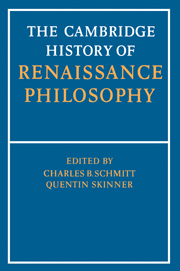Book contents
- Frontmatter
- Introduction
- PART 1 THE INTELLECTUAL CONTEXT
- 1 The conditions of enquiry: Manuscripts
- 2 The conditions of enquiry: Printing and censorship
- 3 The Renaissance concept of philosophy
- 4 Translation, terminology and style in philosophical discourse
- 5 Humanism
- PART 2 PHILOSOPHY AND ITS PARTS
- PART 3 SUPPLEMENTARY MATERIAL
- Biobibliographies
- Bibliography
- Index nominun
- Index rerum
- References
2 - The conditions of enquiry: Printing and censorship
from PART 1 - THE INTELLECTUAL CONTEXT
Published online by Cambridge University Press: 28 March 2008
- Frontmatter
- Introduction
- PART 1 THE INTELLECTUAL CONTEXT
- 1 The conditions of enquiry: Manuscripts
- 2 The conditions of enquiry: Printing and censorship
- 3 The Renaissance concept of philosophy
- 4 Translation, terminology and style in philosophical discourse
- 5 Humanism
- PART 2 PHILOSOPHY AND ITS PARTS
- PART 3 SUPPLEMENTARY MATERIAL
- Biobibliographies
- Bibliography
- Index nominun
- Index rerum
- References
Summary
THE IMPACT OF PRINTING
Printing had an enormous effect on all learning, but its impact was neither revolutionary nor sudden. Instead, over a period of fifty to one hundred years it so greatly facilitated the dissemination of the results of enquiry as to propel philosophy and all other branches of learning into a new era. This brief survey attempts to explain how printing affected the conditions of learning in the Renaissance, and especially how the press communicated the results of scholarly enquiry. The perspective is that of author and reader, with the printer as usually helpful but occasionally as an obstructionist intermediary.
The development of printing
An earlier innovation helped make printing possible: paper came from China through the Near East into the West about 1100. It spread quickly throughout Europe until the majority of manuscript books were written on paper in the early fifteenth century. Paper suited printing far better than vellum (prepared animal skin): it was more pliable, absorbed ink better than vellum, and was considerably cheaper.
Johann Gutenberg at Strasburg and Mainz experimented for years before he and his associates were able to solve the technical problems necessary for printing. Their first major achievement was the beautiful forty-two-line Bible, probably begun in 1452 and certainly completed by 1455. But printing did not make a significant impact on learning until presses had multiplied, their production had diversified, and the reading public had become aroused. This led gradually to a broad system of distribution and marketing. This process began about 1470 and came to full fruition about 1500.
- Type
- Chapter
- Information
- The Cambridge History of Renaissance Philosophy , pp. 25 - 54Publisher: Cambridge University PressPrint publication year: 1988
References
- 6
- Cited by



